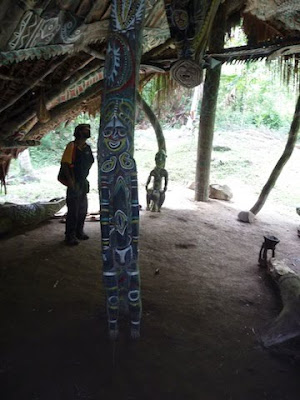Collection 2010
It begins in New Ireland, on the east coast, which still practice rituals Malagan.

sandy beaches, coral reef, coconut ...

A small group of children with blond hair, a trait not uncommon in New Ireland.
Malagan A dance demonstration.
These masks very fragile and bulky should be well protected to prevent breakage during transport. I use a black plastic film and dried banana leaves.


beach under the sun and rain ...
change of scene, back in Waskuk Hills. Is the dry season, rivers become dry hiking trails.
I am led to place a box ceremony was grounding some time ago. Too old, another will soon be built.


of superb post office box in good condition have been abandoned or thrown into the ravine near.

I collected.

Back to the river to reach another village waskuk. These plains are under water during the rainy season.
A box Kwoma ceremonial.
A new step in a stream.
A view of Urumbanj.
Early morning before leaving Waskuk and engine failure to resolve.
water, shallow, is full of sediment and vegetation. That's what gives it that orange color at that hour when the sun's rays are shaving.
Items collected are compiled before being loaded onto the boat.
My lunch while traveling by canoe sweet potatoes, biscuits and corned beef.
new stage in the plains of the Sepik. North of the river, a few hours walking lead to very large villages Sawos.
These villages are accessible via footpaths along wooded streams.
I am greeted by a set of drums on several huge slit drums (garamut) .
This river leads to the village but only small boats can borrow.
Beware the thorns of palm trees are very long.
Sawos Another village and the upper part of a ceremonial house where you can see a sculpture and a ridge of gable mask.
A dance costume waiting in a box.
Another box.
We see in this picture the mat that welcomes the umbrella sculpture. The basis of the mast (which can measure 8m) is sculptured and is a female character.
This wall map defines the area reserved to thirty men who must live apart from the rest of the tribe.


These men were scarified few weeks ago. They will spend two months waiting for the complete healing of their skin, and the performance of the ceremonies that accompany these rites of initiation.

They sleep together on the floor on pieces of bark and spend time discussing and preparing costumes and ornaments to be used for the closing ceremony.
Coat of yellow clay body is part of the rite.
Back to the River. The great difficulty of these villages several kilometers away from the river, is to return the objects to the canoe, especially when heavy as this garamut or mast cell.

Navigation sunrise.
During this expedition, collected objects will be so heavy that it will set a bamboo lattice on three large canoes to transport them.
While we charge, I am amazed at how this woman brings home wood fire. It uses the current, against the current and the hull of his canoe.
New destination, the islands off Wewak in Bismarck Sea. We're full of fuel on the beach.
A pirogue outrigger, which peurt also include a mast and rigging.
These canoes do not have saffron, they are headed with long, heavy paddles as we show these villagers.

All these shells will be fired and plundered to produce this famous lime consumed with betel nut, or used as white pigment on many items.
Paradise View of Mushu.
The coast west of Wewak, whose populations are similar to those of islands.
last step, the area Abelam. On these pictures, the exhibition of large long yam yam masks decorated.
I arrived shortly after a ceremonial harvest of yams, which is why this implementation is still visible.


end of the trip, go in Britain, where all items collected will experience a new life.









































































0 comments:
Post a Comment